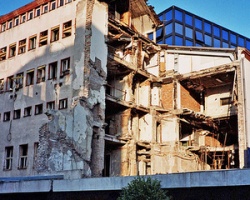Go away for a month, and things pile up. Time to get back at it. Here are “Periodicals Notes” on three recent issues of Counterpunch.
16-30 April: Tiphaine Dickson reports on the case of Dragoljub Milanovic, the only person ever to have been tried and punished for NATO’s 23 April 1999 bombing of Radio Television Serbia (RTS), an attack on an undefended target that killed 16 civilians and served no military purpose other than to disrupt broadcasting between the hours of 2 and 5 AM that morning. The attack followed an ultimatum NATO issued to the Serbs that the station would be considered a legitimate target unless they consented to broadcast six hours a day of NATO-approved western programs, an ultimatum NATO dropped when the Serbs accepted it. Mr Milanovic has been in prison for seven years because of his role in this wanton act of murder. What was that role? He was one of NATO’s intended victims. The director of RTS, Mr Milanovic was at his desk in the building less than an hour before the bombing. Dickson details a story of the dizzyingly absurd injustices that Mr Milanovic has suffered, illustrating the workings of the West’s anti-Serb policies of the last couple of decades.
In the same issue, former US Senator James Abourezk (Democrat of South Dakota) gives a synopsis of the relations between the Minneconjou tribe of the Sioux nation and the US government before, during, and after the 1890 massacre of Minneconjou people at Wounded Knee in South Dakota. This is to serve as an introduction to Senator Abourezk’s recollections in the next issue of the 1973 occupation of Wounded Knee by militant American Indian Movement (AIM) activists.
1-15 May: Senator Abourezk tells the story of his trip to Wounded Knee in 1973, when he and George McGovern (his senior colleague in the US Senate from South Dakota) tried to mediate between AIM and the federal agents surrounding them. The senators left thinking that they had negotiated a peaceful resolution to the standoff, only to find that the Nixon administration had blocked the deal. Senator Abourezk suspects that the president wanted to keep the crisis going in order to stoke anti-Native feeling among whites.
In the same issue, Steven Higgs looks at nanotechnology. After listing such applications as self-cleaning eyeglasses (very attractive to me!), he quotes experts who are concerned that carbon nanotubes strongly resemble the microstructure of asbestos and that exposure to them may pose some of the same risks as does exposure to asbestos. Other nanotechnologies also seem to represent considerable dangers; for example, the minute portions of silver used in high-end washing machines can enter living cells and may alter DNA there, threatening cancer. Higgs notes that after years of federal inaction, the Obama administration has issued notice that it may begin a review of regulations in this area.
16-30 May: Eamonn Fingleton points out that all the explanations for the decline of the US auto industry favored by corporate media are bogus. For example, one often reads that the Big Three fail to produce any models with the steering wheel on the right, and that this explains why the Japanese won’t buy American cars. In fact, Fingleton reports, Detroit makes dozens of models with the steering wheel on the right, and has done so for years. We also hear that closing a country to imports will doom its manufacturers to eventual irrelevance in the global contest for shares of the export market. Yet the Japanese and Korean car markets have been the most tightly closed in the world for decades, as Japanese and Korean car makers have gone from strength to strength and now dominate the US market.
In the same issue, Bill Hatch reports on Michelle Obama’s visit to the University of California’s new campus at Merced. Hatch quotes Mrs O’s criticism of the University of Chicago’s development of the Hyde Park neighborhood as abuffer between itself and the South Side of Chicago, then points out that UC-Merced is trying to do exactly the same thing. Hatch tells how UC-Merced was built during the California real estate bubble, and how the construction of the university and the bubble worked together to shatter the working class town that had existed there. In Hatch’s telling, Merced sounds like a ghost town in the making.

No comments:
Post a Comment